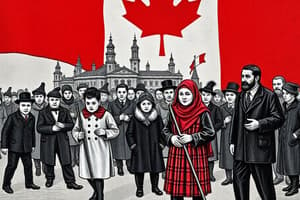Podcast
Questions and Answers
What was one of the main purposes of the Immigration Act of 1910 in Canada?
What was one of the main purposes of the Immigration Act of 1910 in Canada?
- To promote integration of immigrants into Canadian society
- To eliminate the head tax on Chinese immigrants
- To expand government control over immigration (correct)
- To encourage increased immigration from Asia
Which of the following facts is true about Alexander Graham Bell?
Which of the following facts is true about Alexander Graham Bell?
- He developed a hearing aid for the hearing impaired
- He created the first telephone in 1876 (correct)
- He was born in Canada and invented the light bulb
- He was exclusively focused on electrical engineering
How did the head tax affect Chinese immigrants in Canada?
How did the head tax affect Chinese immigrants in Canada?
- It raised the cost of immigration progressively to limit entry (correct)
- It was removed after 1903 to welcome more Chinese immigrants
- It had no impact on Chinese immigration numbers
- It encouraged a significant increase in Chinese immigration
What notable achievement did Martha Black accomplish in Canadian politics?
What notable achievement did Martha Black accomplish in Canadian politics?
Which invention is Elijah McCoy most recognized for?
Which invention is Elijah McCoy most recognized for?
Which of the following accurately describes the achievements of Tom Longboat?
Which of the following accurately describes the achievements of Tom Longboat?
What was the significance of the Married Women’s Property Act?
What was the significance of the Married Women’s Property Act?
In what year did Manitoba, Saskatchewan, and Alberta grant women suffrage?
In what year did Manitoba, Saskatchewan, and Alberta grant women suffrage?
Which prominent figure founded the Canadian Women's Suffrage Association?
Which prominent figure founded the Canadian Women's Suffrage Association?
What event prompted the Immigration Act of 1910?
What event prompted the Immigration Act of 1910?
When did women in Québec finally gain the right to vote?
When did women in Québec finally gain the right to vote?
How did women contribute to the war efforts historically?
How did women contribute to the war efforts historically?
What limitation did the early 1800s impose on women in Canada?
What limitation did the early 1800s impose on women in Canada?
What was the main reason Russia sold Alaska to the United States?
What was the main reason Russia sold Alaska to the United States?
Which significant event helped escalate the border issues between Canada and the United States?
Which significant event helped escalate the border issues between Canada and the United States?
How did the British government respond to the potential threat of an American takeover in Canada?
How did the British government respond to the potential threat of an American takeover in Canada?
What was the outcome of the arbitration decision regarding the Alaska boundary dispute?
What was the outcome of the arbitration decision regarding the Alaska boundary dispute?
Which territories were intended to originally be a single province before being divided?
Which territories were intended to originally be a single province before being divided?
Which Indigenous group was mentioned in the context of the Alaska boundary dispute?
Which Indigenous group was mentioned in the context of the Alaska boundary dispute?
What was a significant consequence of city growth in Canada during the early 1900s?
What was a significant consequence of city growth in Canada during the early 1900s?
What did Americans believe about the location of the coast in the Alaska boundary dispute?
What did Americans believe about the location of the coast in the Alaska boundary dispute?
Flashcards
Colonialism
Colonialism
A policy where a nation seeks to extend its control over other people and territories.
Racism and Bias
Racism and Bias
The practice of discriminating against or treating someone unfairly because of their race or origin.
Tom Longboat
Tom Longboat
A long-distance runner from the Six Nations Reserve who won the Boston Marathon in 1907 with a record time.
Married Women's Property Act
Married Women's Property Act
Signup and view all the flashcards
Suffrage
Suffrage
Signup and view all the flashcards
Gentlemen's Agreement
Gentlemen's Agreement
Signup and view all the flashcards
Dr. Emily Stowe
Dr. Emily Stowe
Signup and view all the flashcards
Dr. Oronhyatekha
Dr. Oronhyatekha
Signup and view all the flashcards
Immigration Act of 1910
Immigration Act of 1910
Signup and view all the flashcards
Head Tax
Head Tax
Signup and view all the flashcards
Immigration in the 1900s
Immigration in the 1900s
Signup and view all the flashcards
Alexander Graham Bell
Alexander Graham Bell
Signup and view all the flashcards
Elijah McCoy
Elijah McCoy
Signup and view all the flashcards
Alaska Boundary Dispute
Alaska Boundary Dispute
Signup and view all the flashcards
Arbitration
Arbitration
Signup and view all the flashcards
Channel Islands
Channel Islands
Signup and view all the flashcards
Purchase
Purchase
Signup and view all the flashcards
Confederation
Confederation
Signup and view all the flashcards
Klondike Gold Rush
Klondike Gold Rush
Signup and view all the flashcards
Rupert's Land
Rupert's Land
Signup and view all the flashcards
Indigenous land use
Indigenous land use
Signup and view all the flashcards
Study Notes
Alaska Boundary Dispute
- The dispute involved the United States and Canada.
- The disagreement centered on the border between southeast Alaska and the western coast of British Columbia.
- Numerous small islands in the area complicated the border issue.
- The U.S. purchased Alaska from Russia in 1867, partly to preempt potential British conquest.
- The U.S. initially wanted to control British Columbia, but British Columbia joined the Canadian Confederation in 1871, ending U.S. ambitions.
- The Klondike Gold Rush led to border disputes.
- Canadians wanted a route from the Klondike River to the Pacific Ocean.
- Americans opposed this due to concerns about Canadian encroachment on their territory.
- This conflict escalated to an international tribunal in 1903.
- Canada believed the coast was located at the western boundary of the channel islands.
- Americans believed the coast was located where the mainland met the Pacific Ocean.
- The final decision favoured the Americans during arbitration.
- The Tlingit are an Indigenous group in the area, and their views were factored into the decision-making process to varying degrees.
Alberta and Saskatchewan
- In the 1850s and 1860s, the British government sought control of Alberta and Saskatchewan for agricultural purposes.
- After Canada's creation in 1867, concerns arose about an American takeover.
- Canada responded by purchasing Rupert's Land and the North-Western Territory from the Hudson's Bay Company.
- The prairies held valuable land suitable for agriculture.
Alberta and Saskatchewan (continued)
- Alberta and Saskatchewan were initially planned as a single province but divided into separate provinces due to their vast size.
- Alberta and Saskatchewan became the 7th and 8th provinces of Canada in 1905 following Confederation.
- The provinces' joining Confederation in 1905 was marked by a lavish banquet.
Indigenous Canada
- During the early 1900s, the growth of Canadian cities replaced Indigenous land use.
- Europeans aggressively seized Indigenous lands, displacing and outnumbering Indigenous peoples over time.
- Colonialism is the policy of a country expanding its authority over other people.
Indigenous Canada (continued)
- Newspapers in the early 1900s featured stories about prominent Indigenous public figures like Tom Longboat and Dr. Oronhyatekha.
- Both of these figures faced racism and bias.
- Tom Longboat achieved a significant record in the Boston Marathon (2:24:24).
- This record was initially downplayed as an accident.
The Changing Role of Women
- In the early 1800s, women's roles were restricted to household management, marriage, and family.
- Business and politics were almost entirely closed off to women.
- Canadian women faced persistent systemic discrimination despite their contributions.
The Changing Role of Women(continued)
- In 1884 in Ontario and 1900 in Manitoba, the Married Women's Property Act granted women equal legal rights to men, including owning property independently, managing earnings, and profits.
- Traditionally, women were excluded from war efforts, although 12 women served as nurses during the Boer War.
Women's Suffrage
- Suffrage is the right to vote in political elections.
- Initially, women's voting rights were not equal to men's, and voting rights were granted to women in Manitoba, Saskatchewan, and Alberta in 1916, followed by most provinces, except Québec, by 1922.
- Women in Quebec obtained this right in 1940.
- Dr. Emily Stowe founded the Canadian Women's Suffrage Association in 1883, advocating for women's rights and achieved local voting rights in Ontario in 1882.
- Bills for women's suffrage in provincial elections failed until 1916, and women gained the right to vote in federal elections in 1918, culminating in Emily Murphy becoming the first female judge in 1916.
Immigration Act of 1910
- Canada's government expanded control over immigration, establishing prohibited immigrant lists.
- The authority was granted to bar immigrants deemed ill-suited to Canada's climate or requirements.
- The government blocked immigrants arriving through charitable groups.
Immigration Act of 1910 (continued)
- Canada had a history of discriminatory immigration restrictions.
- A head tax was levied on Chinese immigrants in 1885.
- The head tax gradually increased to $100 in 1900 and $500 in 1903, limiting Chinese immigration.
- These measures significantly reduced Asian immigration.
Immigration Act of 1910 (continued)
- Despite restrictions, thousands of immigrants arrived in Canada during the 1900s.
- The government needed these immigrants for new job opportunities in new settlements and rising industrialization.
Famous Pioneers
- Alexander Graham Bell (1847–1922), a Scottish immigrant, inventor, scientist, and engineer, invented the telephone.
- Bell was focused on speech due to his deaf mother and wife.
- He demonstrated the telephone on March 7, 1876.
- Martha Louise Black (1866–1957), born in Chicago, worked in the Yukon's gold industry.
- She ran a sawmill and gold ore-crushing plant, delivered lectures on the Yukon and Britain, became a member of the Royal Geographical Society, and was the second woman elected to the House of Commons.
- Elijah McCoy (1844–1929), a Canadian-born inventor, engineer, and African American, acquired 57 patents.
- Notable inventions included an automatic lubricator for steam engines.
Studying That Suits You
Use AI to generate personalized quizzes and flashcards to suit your learning preferences.




